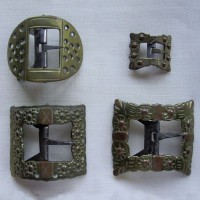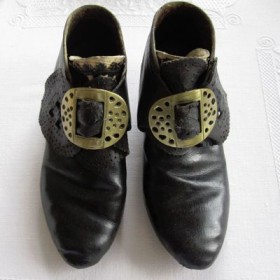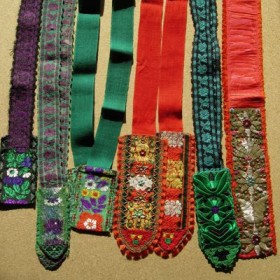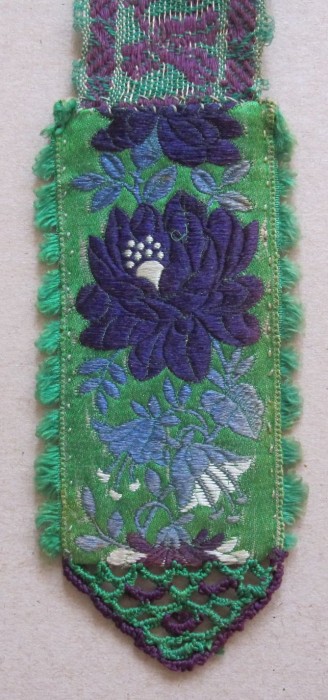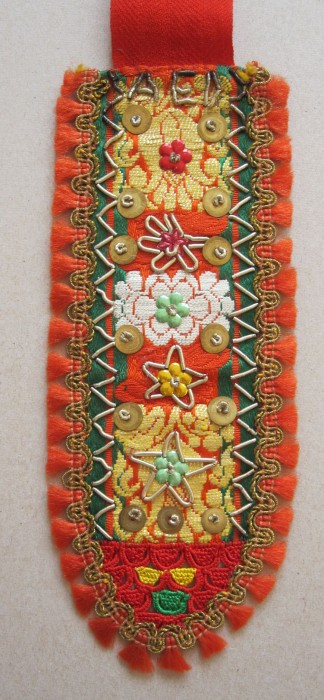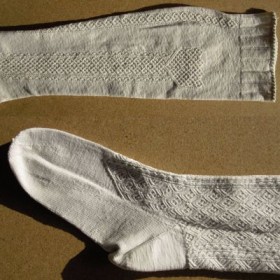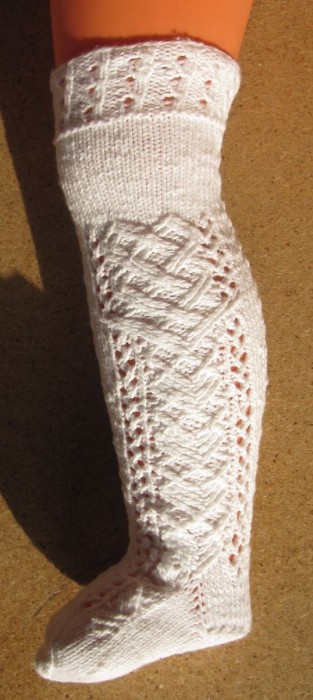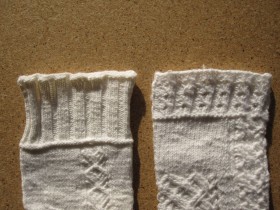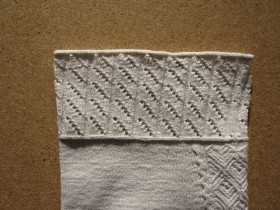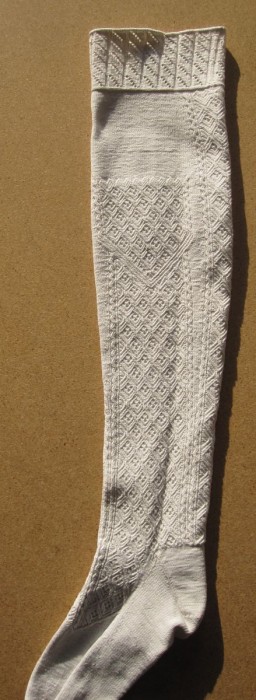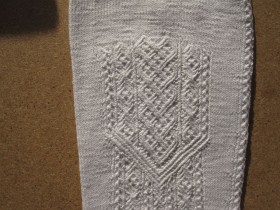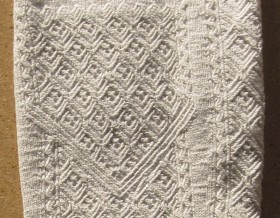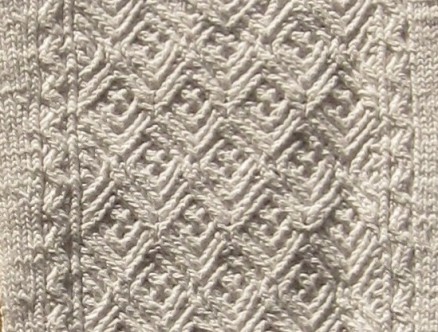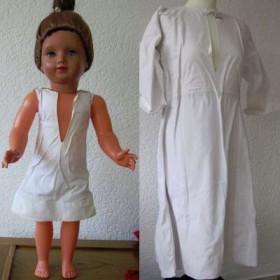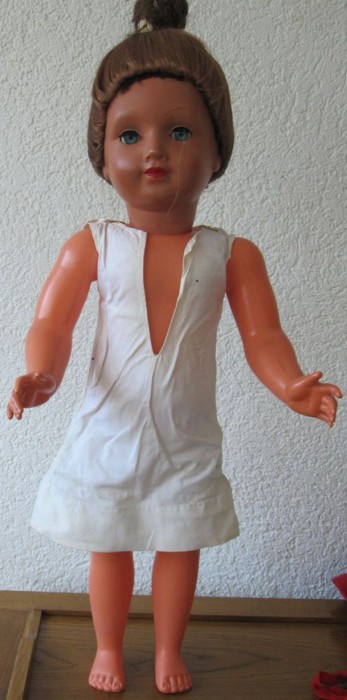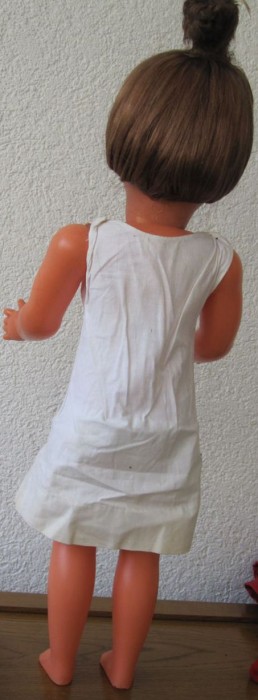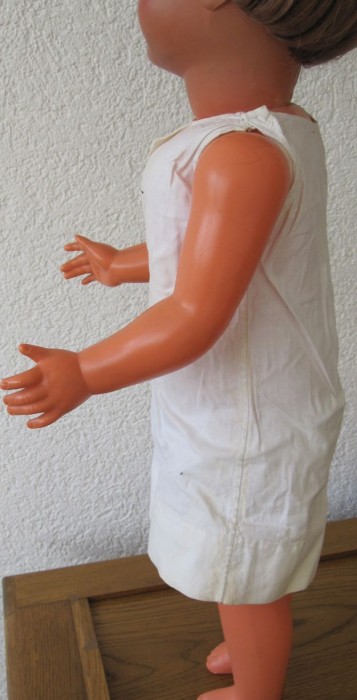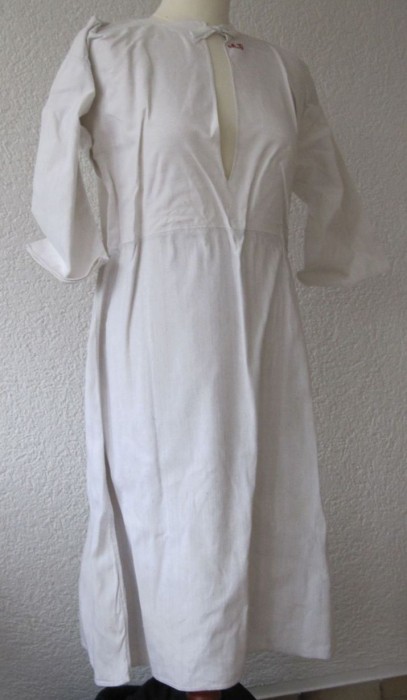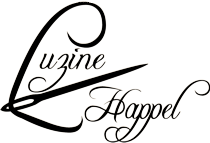The Schwalm buckle shoes were closed with buckles. There were different buckles for special uses.
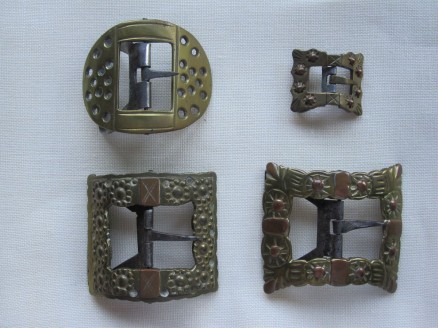
For everyday life women wore pearl buckles. On the surface of these buckles, there was a beady decoration which was created at the foundry.
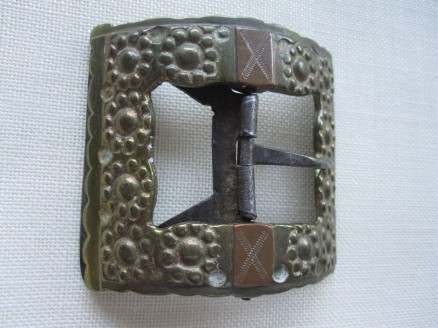
On Sundays, holidays and special festivities the coloured “Eckenschnallen” (corner buckles) were worn. They were the same for men and women, the only difference being in the size. The buckle maker soldered pieces of copper sheet (also as heart or tulip shapes) or added copper rivets. Also the remaining brass areas were decorated with fine chiseling.
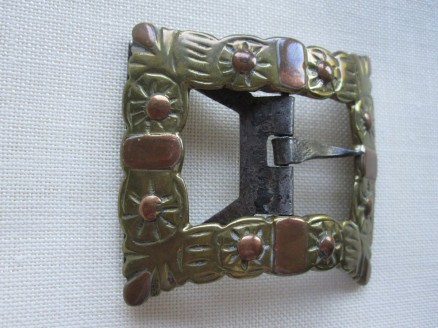
In mourning or for grave occasions, oval buckles (also called “mourning buckles”, “round buckles” or “plain buckles”) were worn. These buckles had holes on each side. Women´s oval buckles had 12 round holes, men´s oval buckles had 8, not always round holes.
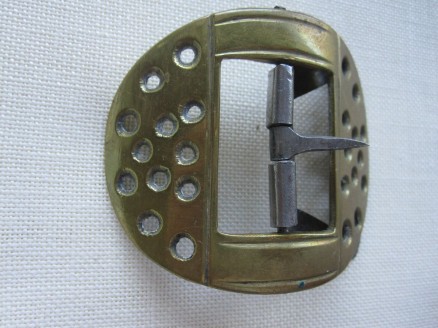
The outside ear of the shoe was turned as wide as possible so to still be able to slide through the heart of the buckle
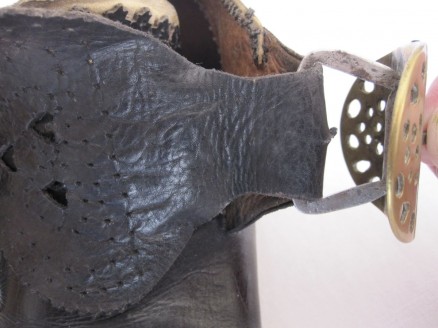
and then the ear was folded so that the tip of the ear was lying on the opposite side of the shoe tongue. Thereby the tip of the heart clawed into the ear.
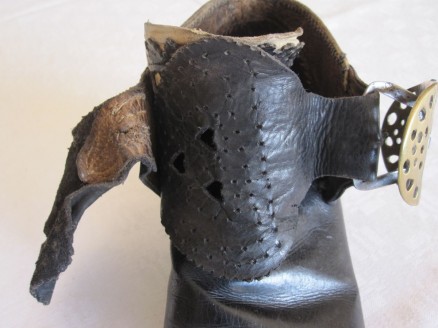
The inside ear was passed through the buckle. The tongue of the buckle bored through the ear and positioned it
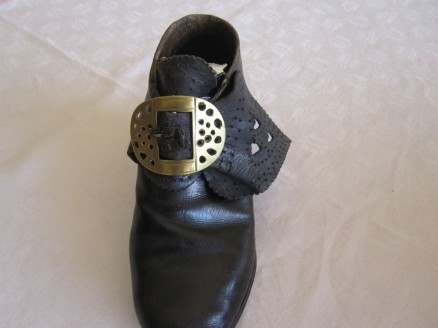
so that the ear was draped at the outside of the shoe.
Remember, the Schwalm shoe fits either the left or right foot. This buckle treatment meant that no matter which foot the shoe was worn on, the ear could be draped to the outside of the foot.
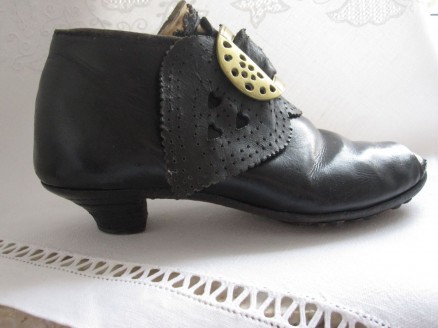
In mourning the inside ear was only passed through the first part of the buckle. The ear part was then laid under the other side of the buckle.
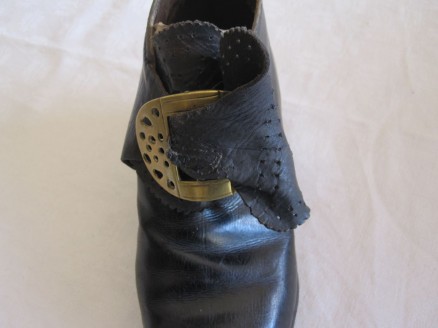
Women always wore buckle shoes with the festive Schwalm costume. Men also had, in addition to the high-necked buckle shoes, lace-up shoes or boots.
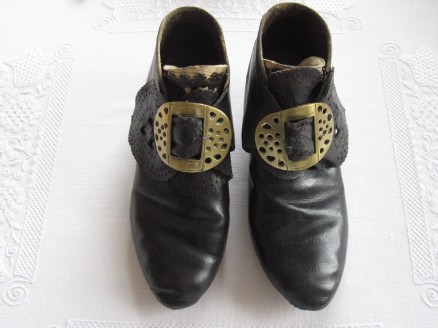
The buckle shoes had rounded toes. The heels were not high and some were smaller than the shoes so that it looked like small blocks lay below the shoes.
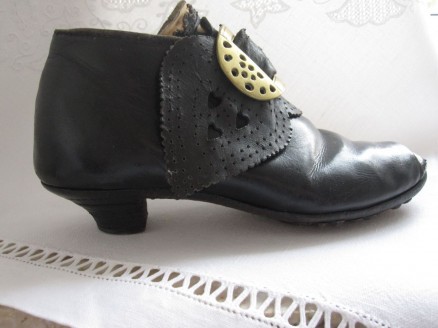
For better footing and longer life some heels were shod.
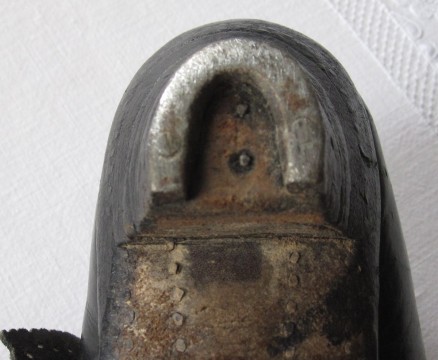
For women’s shoes the shoemaker had only one shoe last, this means, there was no left or right shoe; both were the same and the ladies would alternate wearing them on the left and right feet so that the shoes would wear equally.
Mostly, the shoes were made from calfskin. The punch-decorated tongues of the women’s shoes were serrated at the top edges and accented with white sheep hide.
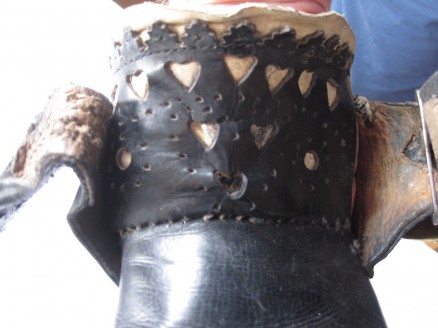
The tongues of the men’s shoes had red piping.
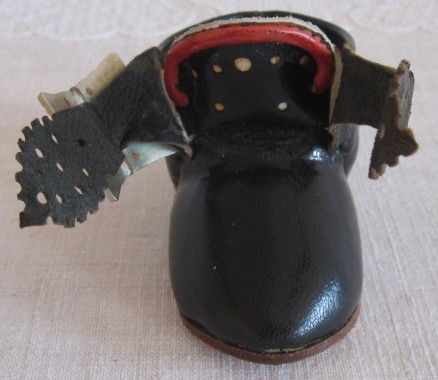
On the sides, there were large tabs in a shape similar to a heart – the “ears”.
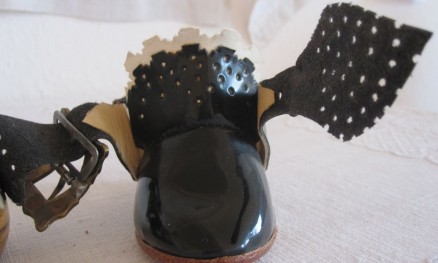
These were decorated with hole ornamentation made with prickers. For marriage shoes, the year was also pricked into the tabs.
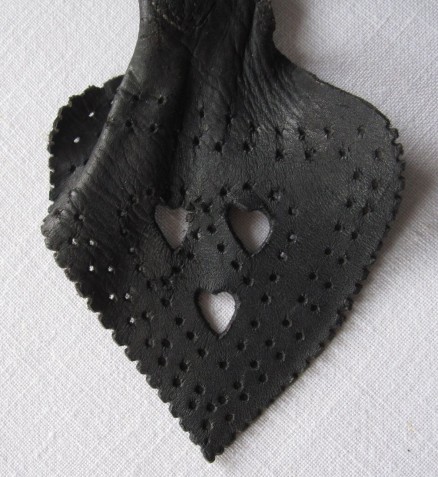
The “ears” were slid through buckles and draped. Thus the Schwalm buckle shoes made an extravagant impression.
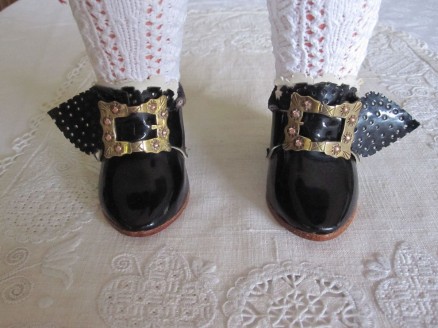
Besides the buckle shoes, the Schwalm women had some more comfortable shoes, the so-called “Kommod” (=commodious) shoes. With flat heels and low cut, they were worn for everyday life and during old age.
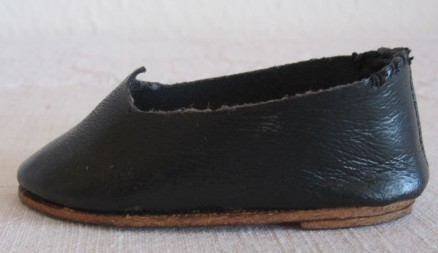
Originally garters simply held up stockings, but as the skirts became shorter the garters became more and more ornate. The result was a wide variety of decorated garters.
Garters are approximately 85 cm long and 3-4 cm wide. The colour of the garter bands matches the colour of the costume worn. All bands have decorated plates at both ends.
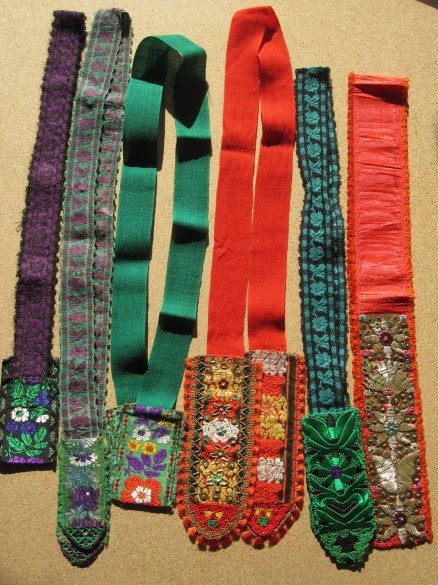
To hold up the stockings, garters were placed around the leg above the knee and were tied so that the plates peeked out below the skirt hem at the side of the leg.
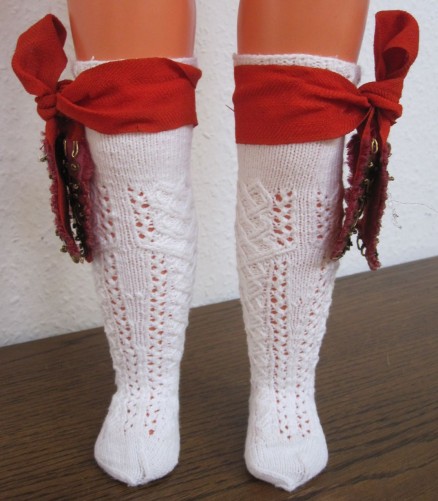
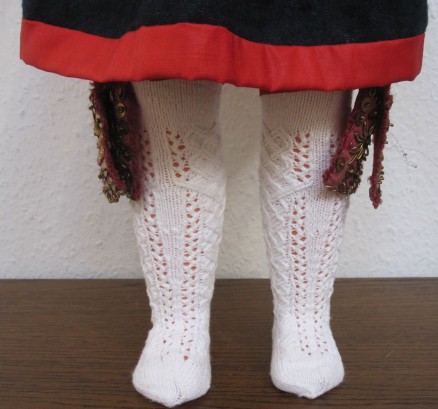 The embellishment of the garters varied greatly. Simple garters had plates of colourful, silk jacquard ribbons.
The embellishment of the garters varied greatly. Simple garters had plates of colourful, silk jacquard ribbons.
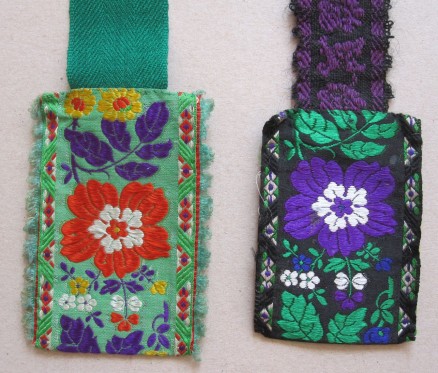 More elaborate examples had an additional decoration of needlelace at the bottom of the plate, or had sequins, or were trimmed with fine metal Purls.
More elaborate examples had an additional decoration of needlelace at the bottom of the plate, or had sequins, or were trimmed with fine metal Purls.
Older pieces often were decorated with “Tritzern”. These are rosettes made from silk ribbons. They were attached to the plates with beads, little blooms of coloured metal or sequins.
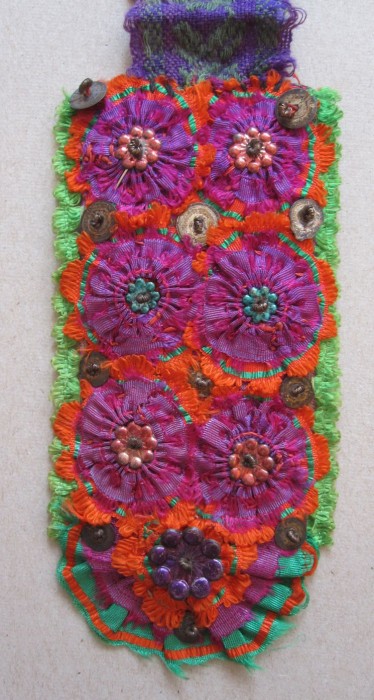 More expensive examples were richly decorated with Purls and sequins. The red costume would have gold accents, while the green costume would have silver accents.
More expensive examples were richly decorated with Purls and sequins. The red costume would have gold accents, while the green costume would have silver accents.
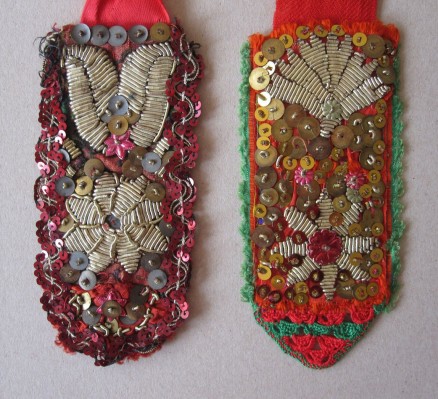 The most impressive garters were those worked in the finest colour embroidery using silk threads.
The most impressive garters were those worked in the finest colour embroidery using silk threads.
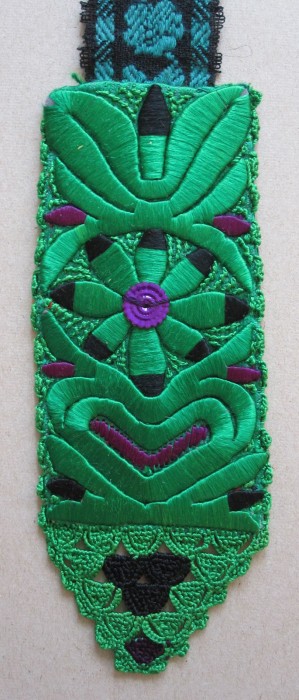
Only the wealthiest women could afford garters worked in the finest colour embroidery using silk threads, additionally decorated with sequins and Purls of gold and silver. Of course, these examples are so rare that I, unfortunately, was not able to get an example to show here.
The Schwalm people wore hand-knit stockings that reached well past the knees. The stockings were held up with garters bound around the legs.
In the year 1930, a poor bride would possess six to eight pairs of stockings, while the rich bride would have 40 pairs in her trousseau.
Originally, summer stockings were knit from linen yarn, later on cotton was used. Cotton yarn made its first appearance in the Schwalm around 1830. For the Winter stockings finely spun sheep´s wool was used. The women´s stockings were white, the men´s stockings were white and sometimes dyed to blue. In order to achieve a bright white stocking, the sheep-woolen Winter stockings were bleached.
Specifically patterned stockings were worn on different occasions. The “Linkten” – stockings with patterns made with purl stitches – were worn during mourning and by old wives. The “Zwickelstrümpfe” (Zwickel = gusset, crotch) with small pattern-stripes were worn during everyday life. They were usually made from thicker yarn. On Sunday, “Zwickelstrümpfe” with wide pattern-stripes were worn; these were made from fine yarn. For special festive days and holidays, “stolze Zwickelstrümpfe” (stolz = proud) were worn. (In the Schwalm, the label “stolz” was given to all things especially gorgeous and elaborately decorated.) The “stolzen Zwickelstrümpfe” were knitted with very fine yarn and had especially beautiful and elaborate patterns with extra wide pattern-stripes. The “eingelegten” (= inlaid) stockings were a specialty. These “Zwickelstrümpfe” had elaborate knitting patterns in which an additional thread was carried and, depending on the pattern, alternately laid before or behind the stitches. (One could get the impression that those stockings were embroidered after knitting. That is not the case – it is a pure knitting pattern.)
Because the techniques involved were extremely difficult, only the most talented knitter or the richest women could afford this impressive kind of “Zwickelstrümpfe”. Of especial worth are stockings in which the initials or the year were knitted: here, “AKE” for Anna Katharina Ermel.
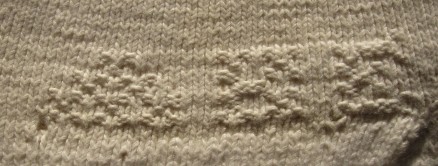
The stockings were knit in rounds, from cuff to toe, employing five fine knitting needles. They were composed of different sections. The cuff was a 5-10 cm high stripe or band. The “Börtchen” ( = small border) was knit according to the occasion for which it was meant to be worn. The “Börtchen” pattern might be a simple knit 2, purl 2 rib, a peekaboo or pigtail design.
At the back of the stocking, from bottom of the “Börtchen” and down to the heel, runs a small straight pattern-stripe called “Nähtche” (= small seam). The remainder of the area under the “Börtchen” and past the knee, plain stockinette stitch is worked for a some centimeters.
Now, along both sides of the calf runs a pattern-stripe, beginning with the “Platte” ( = plate).
The “Platte” had the shape of a pentagon. The “Platte” was a little bit wider than the pattern-stripe below it. For the “Platte” there were two different possibilities: either it was made with the same patterns as the stripe below, only wider, or a large design was knit in its middle. The large design was usually a heart pattern with a small stripe, based on the stripe below, on both sides. This “Zwickelmuster” ran down to the heel.
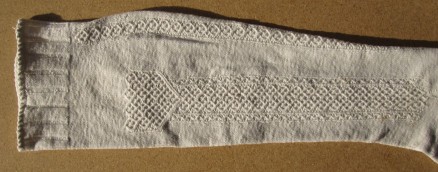
On women´s stockings, the pattern continued onto the top of the foot to the toes. This is because women wore not only the buckle shoes, but also the low-cut “Kommod” (= commodious) shoes. On the men´s stockings, the pattern ended at the top of the heels. This is because men only wore the high-necked buckle or lace-up (for everyday life) shoes or boots.
On many women’s stockings a very narrow, straight pattern band with a curved pattern, called “Schlängchen” (= small snake), ran on both sides of the “Zwickel”.
Between the pattern-stripes, a gusset was created so that the stocking would better fit the leg form.
However, in Schwalm the pattern-stripes on the sides were called gusset, not the special shaping done between the pattern-stripes.

Heels, soles of the foot and toes were worked in stockinette stitch. Casting off the tip was mostly made in a star form.
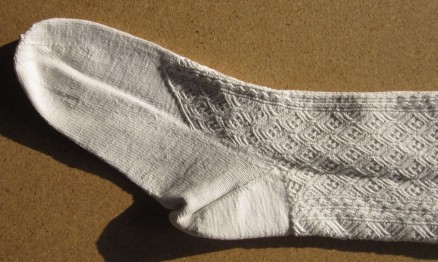
There are many different knitting patterns playing a role in Schwalm knitting. I will show some of them in future posts.
As already mentioned in “Schwalm Costume – an overview“, the festive costume consisted of many different elements. Where to begin? Pure and simple, where we all normally start dressing – with the underclothing.
Women in the Schwalm wore undershirts. I do not know of underpants at the time. Later, when the Schwalm woman will be fully dressed, you will be able to imagine why.
The undershirt was made from pure linen. It was a little more than knee long and simply shaped – a little bit wider at the bottom.
The Summer-undershirt was sleeveless and without any closure. The Winter-undershirt had long sleeves and maybe a band for closing.
